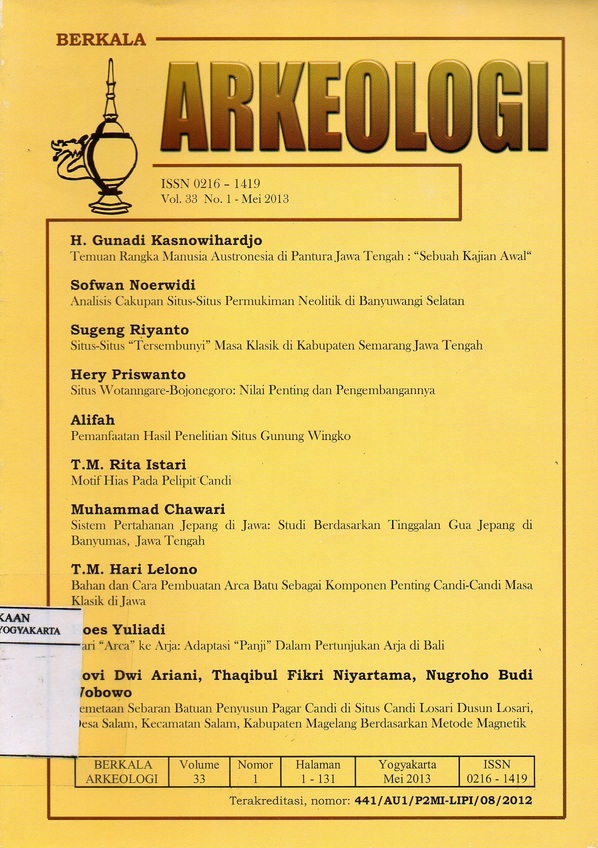DARI ARCA KE ARJA: ADAPTASI PANJI DALAM PERTUNJUKAN ARJA DI BALI
Main Article Content
Abstract
Panji stories that were spread throughout Indonesia and Southeast Asia were not only known as old literature. Panji stories were also sculpted as the reliefs on temples in East Java. The existence of the text shows the historical facts that form the basis for the emergence of the Panji stories. Panji figure could be a manifestation of the life of kings in the past. The presence of papyrus, relief, and also stage performance that tell the story of Panji showed that there is a correlation among literature, relief, and performance, in the realm of art creation. Are Panji stories stay preserved as part of the development of art in Indonesia? Arja performances in Bali could describe how Panji stories can still be traced. Arja's performance used Panji stories as a source. Now Arja is existence can still be seen through its variety of plays. However, this does not make the panji story disappear in the Arja's performance. This issue will be addressed as a consequence of the adaptation of the revolving art. Not only in the present, but in the past a pattern of adaptation that can transpose works from different disciplines has already emerged. Panji stories can be known through papyrus, relief, and performances. Today it is still going without being recognized.
Article Details

This work is licensed under a Creative Commons Attribution-NonCommercial-ShareAlike 4.0 International License.
References
Baried, Siti Baroroh, dkk. 1987, Panji: Citra Pahlawan Nusantara. Jakarta: Departemen Pendidikan dan Kebudayaan.
Baudrillard, Jean. 2001. Galaksi Simulacra. Yogyakarta: LKIS.
Brandon, James R. 198., Seni Pertunjukan di Asia Tenggara, terj. Soedarsono. Yogyakarta: ISI Yogyakarta.
Butler, Judith. 2008. Gender Trouble Feminism and the Subversion of Identity. New York and London: Routledge.
De Cock, Ch – Wheatley. 2012. "The Lot of the Balinese Eve" dalam Adrian Vickers Bali Tempo Doeloe, terj. Tim Komunitas Bambu. Jogjakarta: Komunitas Bambu.
Dibia, I Wayan. 1992. Arja: A Sung Dance-Drama of Bali; A Study of Change and Transformation. Disertation. Los Angeles: University of California.
Hutcheon, Linda. 1988. A Poetic of Postmodern History, Theory, Fiction. London and New York: Routledge.
_____________. 2006. A Theory of Adaptation. London and New York: Routledge Taylor & Francis Group.
Kieven, Lydia, 2009, “Panji di Gunung Penanggungan†dalam Henri Nurcahyo (ed.) Konservasi Budaya Panji. Surabaya: Dewan Kesenian Jawa Timur.
Munandar, Agus. 2005. “Tinjauan Ringkas Candi Miri Gambar†dalam Kalajantra: Kumpulan Kajian Arkeologi Hindu-Buddha Jawa Timur. Depok: Laboratorium Arkeologi, Program Studi Arkeologi, Fakultas Ilmu Pengetahuan Budaya Universitas Indonesia.
McRobbie, Angela. 2011. Postmodernisme dan Budaya Populer, terj. Nurhadi. Jogjakarta: Kreasi Wacana.
Poerbatjaraka. 1968. Tjerita Panji dalam Perbandingan. Djakarta: Gunung Agung.
Sawitri, Cok. 2003. “Perempuan Versus Laki-laki Perseteruan dalam Seni Pertunjukan Bali†dalam Urs Ramseyer & I Gusti Panji Tisna (ed.) Bali Dalam Dua Dunia Potret Diri yang Kritis. Bali: MatameraBook.
Spencer, Colin. 2004. Sejarah Homoseksualitas: dari Zaman Kuno hingga Sekarang, terj. Ninik Rochani Sjams. Jogjakarta: Kreasi Wacana.

